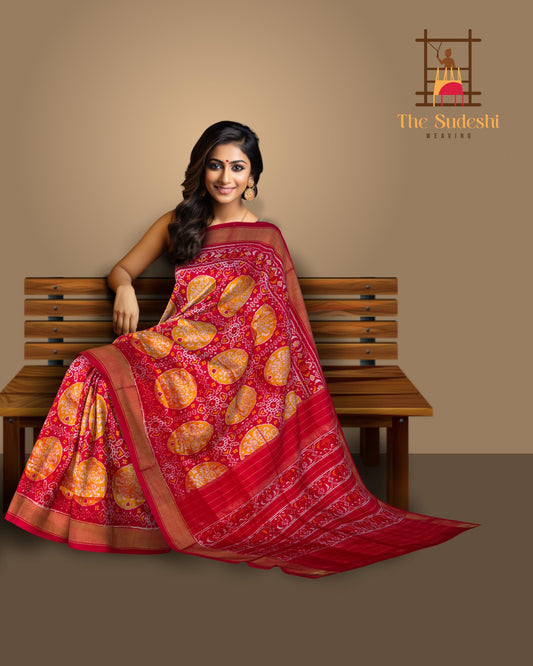How to Tie the Kosuvam: A Step-by-Step Guide to Perfectly Secure Saree Ends
Sarees are more than just garments; they are a timeless representation of grace, tradition, and cultural heritage. Among the many intricate details that make sarees so special, the way the kosuvam (the end of the saree, also known as the pallu) is tied plays a crucial role in completing the look. Whether you’re preparing for a traditional event, a wedding, or just want to master the art of draping a saree perfectly, learning how to tie the kosuvam correctly is essential.
In this guide, we’ll walk you through the process of tying the kosuvam, offering tips and techniques to ensure that your saree looks flawless every time. Whether you're a beginner or someone looking to refine your technique, this step-by-step guide will help you achieve a polished and elegant look.
Understanding the Importance of the Kosuvam
Before we dive into the steps, let’s take a moment to understand why tying the kosuvam is so important. The kosuvam is not just the end of the saree; it’s a focal point that adds balance and symmetry to your drape. A well-tied kosuvam enhances the overall appearance of the saree, adding to the elegance and grace of your outfit. It also ensures that the saree stays in place, allowing you to move freely without constantly adjusting your drape.
Step 1: Choosing the Right Saree
The first step in tying the perfect kosuvam starts with selecting the right saree. Different sarees, such as silk, cotton, or synthetic materials, have unique textures and weights that can affect how the kosuvam is tied. Silk sarees, for instance, are heavier and tend to stay in place more easily, while lighter materials may require additional pinning or adjustments.
When choosing a saree, consider the occasion, the comfort of the material, and how easy it is to manage the kosuvam. For beginners, starting with a saree that has a well-defined border can make the process easier, as the border helps in aligning and folding the kosuvam neatly.
Step 2: Draping the Saree
Start by draping the saree around your waist, with the non-pallu end tucked securely into your petticoat. Wrap the saree around your waist once more, bringing the pallu over your left shoulder. Ensure that the saree is wrapped snugly, with the pleats falling evenly.
At this stage, the length of the pallu should be adjusted according to your preference. Some prefer a longer pallu that drapes elegantly down the back, while others might choose a shorter pallu that stays closer to the body. The key is to make sure that the pallu is even and that the kosuvam has enough length to be tied securely.
Step 3: Creating the Kosuvam
Now that the saree is draped, it’s time to focus on the kosuvam. Gather the pallu in your hand, making sure that it is smooth and free of any creases. Depending on the style of saree and the look you want to achieve, you can either pleat the kosuvam or leave it open.
Pleated Kosuvam: To pleat the kosuvam, start by folding the pallu into small, even pleats, each about 4-5 inches wide. Hold the pleats firmly as you fold, ensuring that they are straight and aligned. Once all the pleats are made, secure them with a safety pin to keep them in place. This pleated look is perfect for formal occasions and adds a touch of sophistication to your saree.
Open Kosuvam: If you prefer an open kosuvam, simply gather the pallu in your hand without pleating it. This style is more casual and allows the fabric to flow freely, creating a softer and more relaxed look.
Step 4: Securing the Kosuvam
Once the kosuvam is prepared, it’s time to tie it securely. There are several ways to tie the kosuvam, depending on the look you want to achieve and the type of saree you’re wearing.
The Classic Knot: The most common way to tie the kosuvam is by making a simple knot at the end of the pallu. To do this, take the end of the pallu and tie it into a knot at your waist. Make sure the knot is tight enough to hold the saree in place but not so tight that it bunches up the fabric. This classic knot is ideal for sarees with heavier fabrics, as it helps to anchor the saree securely.
The Waist Tuck: Another popular method is to tuck the end of the kosuvam into the waistband of your petticoat. This technique works well with lighter sarees and helps to create a clean, streamlined look. If you choose this method, make sure to tuck the kosuvam neatly, so it lies flat against your waist.
The Pin-Up: For those who want extra security, especially with slippery fabrics, pinning the kosuvam in place is a great option. Use a safety pin to attach the end of the pallu to your blouse or the saree’s body. This method is particularly useful for sarees with intricate borders or embroidery, as it keeps the kosuvam in place without obscuring the design.
Step 5: Final Adjustments
After tying the kosuvam, take a moment to adjust the saree. Ensure that the pleats are even, the pallu falls gracefully, and the kosuvam is securely tied. Make any final adjustments to the drape, ensuring that the saree sits comfortably on your body.
If you’ve chosen to pleat the kosuvam, check that the pleats are straight and aligned. For an open kosuvam, make sure the fabric flows smoothly without any twists or creases. These final touches are what make the difference between a neatly draped saree and one that looks haphazard.
Tips for a Flawless Kosuvam
- Practice Makes Perfect: Tying the kosuvam perfectly takes practice. Don’t be discouraged if it doesn’t come out right the first time. With each attempt, you’ll become more confident and skilled in handling the fabric.
- Use Pins Wisely: While pins can help secure the saree, use them sparingly to avoid damaging the fabric. Always choose pins that are discreet and match the color of the saree.
- Pay Attention to Fabric: Different fabrics behave differently, so adjust your technique accordingly. For instance, heavier fabrics may need less pinning, while lighter fabrics might require more secure tucking.
- Experiment with Styles: Don’t be afraid to experiment with different ways of tying the kosuvam. Whether you prefer a classic knot, a neat tuck, or an open drape, find the style that suits your saree and the occasion.
Conclusion
Mastering the art of tying the kosuvam is a key skill in achieving the perfect saree drape. Whether you’re dressing up for a special event or just want to enhance your everyday saree look, following these steps will help you tie the kosuvam with confidence and style. Remember, the kosuvam is more than just a functional part of the saree—it’s an expression of your personal style and cultural heritage. So take the time to perfect your technique and enjoy the timeless elegance that a well-tied saree brings.







Leave a comment
Please note, comments need to be approved before they are published.